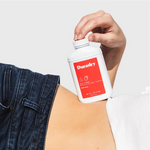There are several causes of rash in the armpits, including irritant contact dermatitis, intertrigo, and erythrasma. Understanding these causes will help you identify what treatment is right for you. A body cleanser made from natural ingredients will provide soothing relief to inflamed skin. Witch hazel and tea tree oil can be used as body cleansers, as they contain natural antibacterial properties. Alternatively, you can use baby powder to soothe the affected area.
1. Allergic contact dermatitis
An allergic contact dermatitis rash in the armpit can be extremely uncomfortable. Fortunately, treating this condition is easy. The most important thing to do is to avoid exposing yourself to the irritant. Typically, a new deodorant or detergent can be the culprit. However, if you suspect that your symptoms are related to a different allergen, you should seek medical attention. In the meantime, you can try a home remedy to soothe your rashes or use an over-the-counter medicine to alleviate your symptoms.
In most cases, allergic contact dermatitis rashes are temporary and will disappear on their own when the offending agent is no longer present. However, the rash may recur after repeated exposure. For this reason, it is important to educate yourself on the causes of allergic contact dermatitis and how to protect yourself from them. In addition, it is important to wear protective clothing that will protect you from the irritants that cause the rash.
The common causes of allergic contact dermatitis rashes include skin care products, food products, and the environment. In the United States, poison ivy is a common allergen, and some people may develop an allergic reaction to it. Another common cause of an allergic contact dermatitis rash in the armpits is ringworm. As the rash develops, the infection will cause multiple patches of red, itchy skin, which will spread outward.
2. Irritant dermatitis
Irritating dermatitis in the armpits is an itchy red skin rash that can be chronic or short-lived. There are many causes of armpit rashes, and some of them can be treated with over-the-counter medicine. In severe cases, however, medical treatment may be necessary. Some types of irritant dermatitis require prescription medications.
The most common cause of irritant dermatitis in arms and armpits is overexposure to the sun. The sun's heat can aggravate the condition, making it more difficult to treat. You can avoid sun exposure and apply talcum powder to reduce irritation. To relieve the itching, stay in cool places, and avoid sweating. In addition, you can make your own deodorant.
Inflammatory dermatitis in the armpits is also known as atopic dermatitis. It can be hereditary and can also be exacerbated by hormones and stress. It can be chronic or come and go for years.
Atopic dermatitis can be triggered by any number of factors, such as shaving creams, deodorants, and antiperspirants. The resulting inflammation can lead to blisters and redness, and it can also cause itching and discomfort. In some cases, the rash may become infected. It is important to seek medical treatment if you suspect irritant dermatitis in the armpits.
3. Intertrigo
Some common causes of a rash in the armpits are allergy and skin problems. If you think that your rash is allergic to something, it's best to seek medical attention right away. If the rash persists after two days, you should see a dermatologist. If the rash is painful, it may be an allergic reaction, so it's important to consult a doctor. If you notice a white rash that does not seem to improve, apply colloidal oatmeal to the rash. This substance is a fine-milled oats solution that will soothe your skin and heal the rash.
A deeper cause of your rash may be more serious. If you notice symptoms such as fever, sore throat, headache, joint stiffness, or cough, it is important to see a doctor. In some severe cases, a skin biopsy may be required. However, the most important prevention method for armpit rashes is maintaining proper hygiene. Showering regularly and air-drying your armpits can help you avoid this problem.
Irritation of the skin is another common cause of rash in the armpits. There are various personal hygiene products that can irritate the skin and cause a rash. Some of these products can trigger a hypersensitivity reaction. While others may not produce an immediate rash, the discomfort associated with an itch is significant. Chafing can accompany the rash in the armpits. Unlike sweat rashes, chafing rashes are red and can be itchy.
4. Erythrasma
Erythrasma in the armpit is an inflammation that develops between the folds of skin in the armpit and groin. If left untreated, it can become chronic and reoccur. The doctor may prescribe antibacterial lotions or pills to treat it. Treatment can take two to four weeks and may require a combination of different treatments.
Erythrasma is caused by a bacterium called Corynebacterium minutissimum. This bacterium causes this skin infection, which is more common in areas with warm climates. Erythrasma typically appears as red, crusty, itchy patches in the skin folds, and varies in size. Symptoms can mimic other fungal infections, including tinea.
Treatment of erythrasma is usually self-limiting, but it can develop into postinflammatory pigmentation, lichenification, and coinfection with another organism. Although this condition is rarely life-threatening, it can lead to serious health complications, including pyelonephritis and endocarditis. Treatment with antibiotics may help. However, recurrence of the condition is common, and antibiotics must be taken carefully and consistently to prevent a recurrence.

5. Tinea corporis
Tinea corporis is caused by dermatophytes that attach to keratinized skin tissue. Most of these fungi belong to the genus Trichophyton rubrum, which comprises 80 to 90% of the known dermatophyte strains. However, the more severe forms of the disease are caused by other fungi, such as Microsporum audouinii and T. mentagrophytes.
The fungi that cause tinea imbricata live on objects in warm climates and can be found on the body. It is also common in animals, and people of all sexes and races can contract it. The fungi that cause tinea are capable of living on many surfaces, including clothing, hair, and nails. If you suspect you have this infection, it is important to see a doctor as soon as possible.
Treatment of tinea corporis can consist of a topical antifungal agent that is applied to the affected area once or twice a day. The medication is applied for two to three weeks, and the endpoint of therapy is clinical resolution of symptoms. For cases of more severe infection, oral therapy may be required. In such cases, oral terbinafine is preferred over itraconazole. Treatment will typically clear up the rash within two to three weeks.
Antihistamines and over-the-counter medications are available to help ease the symptoms and prevent further infection. If your rash is caused by a fungus, doctors may prescribe an antifungal cream or medication to relieve the symptoms. However, if you have a chronic skin condition like eczema, your doctor will most likely recommend a combination of OTC and at-home treatments before prescribing medication.
6. Acanthosis Nigricans
It is a type of skin disorder that causes light brown or black spots on the skin. The main trigger for acanthosis nigricans is an increased level of insulin in the bloodstream. This hormone acts on the epidermis to promote keratinocyte proliferation, which in turn stimulates cell growth. However, other mediators have been implicated, including transforming growth factor (TGF) -1. Generally, the condition progresses until puberty.
Although acanthosis nigricans does not cause any serious medical problems, it can be a sign of a more serious condition. A dermatologist or healthcare provider can order blood tests to rule out underlying conditions. Moreover, people with this condition are more likely to develop diabetes in the future. Symptoms associated with acanthosis nigricans can be treated with the help of an appropriate medication.
Acanthosis nigricans is not contagious and cannot be passed from one person to another. However, you should avoid skin scrubs, bleaches, and other treatments that could irritate the skin. Moreover, it is better to stay away from processed and sugary foods.
The most common symptoms of acanthosis nigricans are hyperkeratosis and hyperpigmentation. Affected patients may also notice changes in the color and texture of their skin. These changes may take months or even years to appear. If left untreated, the condition can progress into more serious conditions, including skin cancer. If you notice these symptoms, consult a dermatologist to rule out the condition.



